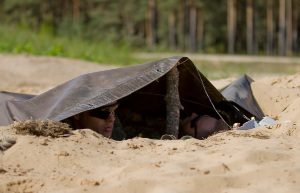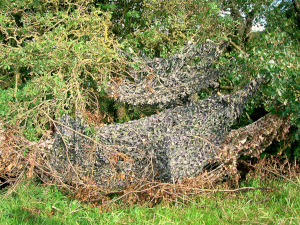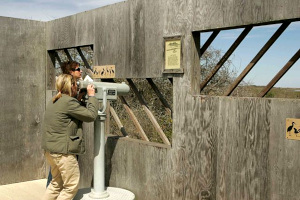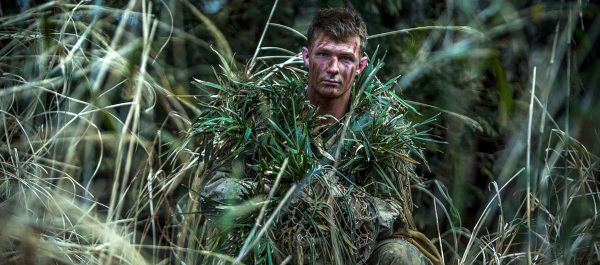Sitting quietly in an inconspicuous spot offering things that birds like -- food, water, good perches -- doesn't sound like much of a strategy for seeing birds, but it's a good start. However, it can be improved a great deal.
 German soldiers on a training mission; photo by Sgt. James Avery, US Army; image courtesy of US Army and Wikimedia Commons
German soldiers on a training mission; photo by Sgt. James Avery, US Army; image courtesy of US Army and Wikimedia CommonsFor example, the better hidden you are, the more birds you can see up close. At the right is a good example of what could be done. The tarpaulin hides any movement or human shape that might upset a bird. The tarp doesn't need to be covered with camouflage patterns, though that might help. You don't have to be in a foxhole like the soldiers, though that might be best, too. Just lying quietly beneath a tarp not far from a bird feeder will bring some birds.
Another idea is to remember that while certain bird species seem able to conceive numbers up to about seven, most birds can count to approximately "one." Therefore, if you have a bird feeder, you might consider placing not too close to it a large cardboard box with a peep-hole in it, big enough to hold you. Let the birds become accustomed to the box being there, so that they're visiting the feeder as always. Then have a friend accompany you there, you enter the box, but have your friend go away. Then just wait for the birds to come. The birds have seen "one" thing approach the feeders, and then "one" thing walk away!
If a cardboard box isn't handy, but there's a stepladder large enough to hide inside of, and a sheet to cover it, those items work, too.
 A hide with camouflage netting on the Bow Burn, Kerse Castle, East Ayrshire, Scotland; image courtesy of 'Rosser1954' and Wikimedia Commons
A hide with camouflage netting on the Bow Burn, Kerse Castle, East Ayrshire, Scotland; image courtesy of 'Rosser1954' and Wikimedia CommonsThe cardboard box idea can be improved on in many ways. Think in terms of making your "hide" even less conspicuous than simply being "something not moving." Anything you do to cut down on the hide's straight lines, sharp angles, broad flat surfaces and bright colors will help. Think in terms of earth-colored "camouflage." Maybe even make it more comfortable for yourself than a cardboard box. At the left you see a vast improvement on the cardboard box idea, though your own creation doesn't really need to rise to that state of perfection. Birds are a little forgiving in these matters, at least backyard ones.
 Visitors at a wildlife refuge watching birds; image courtesy of Steve Hillebrand, US Fish & Wildlife Service
Visitors at a wildlife refuge watching birds; image courtesy of Steve Hillebrand, US Fish & Wildlife ServiceWild birds spook much more easily than backyard ones. At certain wildlife reserves and parks that situation is addressed by providing structures like what's shown at the right. Birds are accustomed to the small building being there, so they come near it. It's the cardboard-box-near-the-birdfeeder trick, just on a grander scale.
Once you've had a bit of bird-stalking experience, if someday you head to the tropics to do some really high-calibre birding, you may find yourself using all the above tricks, and even more. What bird wouldn't come near to the fellow shown below, if only out of curiosity?
